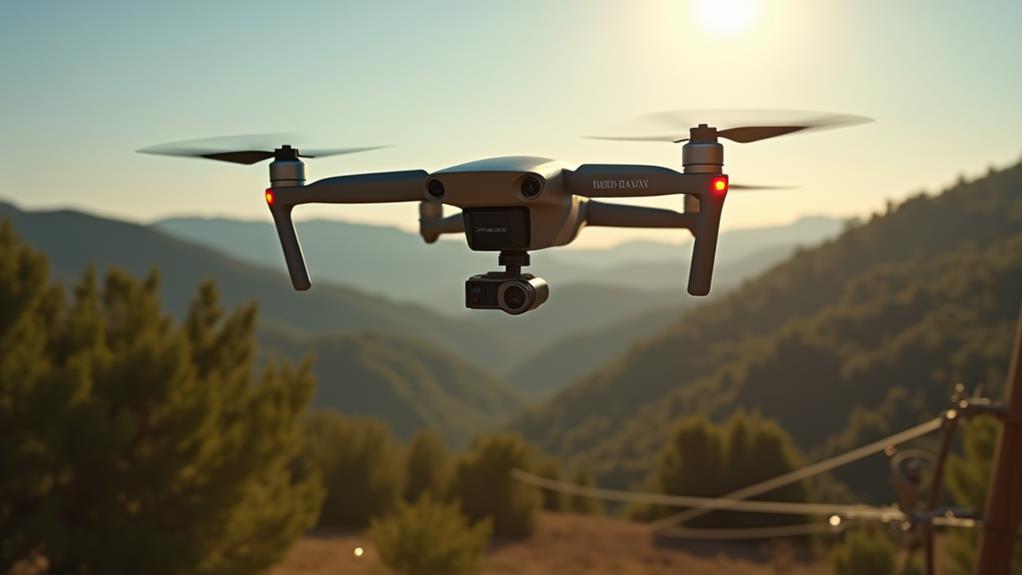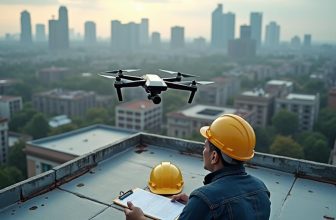
As you gaze out at the intricate web of powerlines crisscrossing the landscape, it's like looking at the lifeblood of modern society. But maintaining this complex network can be a formidable task, with thousands of miles of lines to inspect and repair. That's where powerline inspection drones come in – equipped with advanced sensors and cameras, they can autonomously navigate along powerline routes, capturing real-time data on line conditions and detecting defects. But what exactly makes these drones so effective, and how can utility companies harness their power to revolutionize their maintenance operations – and what are the implications?
Contents
Key Takeaways
- Drones reduce powerline inspection costs, enhance safety, and increase inspection productivity in various weather conditions.
- Advanced drone autonomy and sensor integration enable efficient data collection on powerline conditions.
- Drones can inspect powerlines in difficult or impossible areas for humans to access, creating safer maintenance programs.
- Collected data is analyzed to identify potential issues or defects, prioritizing maintenance and repairs based on inspection results.
- Utility companies benefit from streamlined maintenance operations, enhanced regulatory compliance, and lower operating costs.
Advantages of Drone Inspection
Inspecting powerlines with drones offers numerous benefits, especially when compared to traditional methods that rely on helicopters, manned aircraft, or ground-based crews.
By using drones, you can notably reduce the costs associated with powerline inspection. For instance, drones don't require the same level of fuel and maintenance as helicopters or manned aircraft. Additionally, you won't need to pay for pilot training or salaries, resulting in substantial cost savings.
Another major advantage of drone inspection is enhanced safety. Traditional methods often involve putting personnel at risk, whether it's flying in a helicopter or climbing towers.
With drones, you minimize the risk of injury or death. Drones can also inspect powerlines in areas that are difficult or impossible for humans to access, such as remote or hard-to-reach locations. This allows you to inspect your entire powerline network more efficiently and effectively.
Moreover, drones can operate in a variety of weather conditions, reducing downtime and increasing overall inspection productivity. By switching to drone inspection, you can create a safer and more efficient powerline maintenance program.
Drone Technology and Features
Several key drone technologies and features make powerline inspection a highly efficient and effective process.
You'll find that advanced drone autonomy is a critical component, enabling the drone to fly and inspect powerlines without manual intervention.
This autonomy allows the drone to navigate through challenging terrain and inspect powerlines in remote areas, reducing the risk of accidents and improving overall efficiency.
Drone autonomy is complemented by sensor integration, which provides real-time data on powerline conditions.
Advanced sensors, such as high-resolution cameras, multispectral and hyperspectral sensors, and LiDAR, can detect even the smallest defects and anomalies.
This data is used to create detailed 3D models of the powerline infrastructure, enabling you to identify potential issues before they become major problems.
Sensor integration also enables real-time monitoring of powerline conditions, allowing you to respond quickly to changes in the environment.
This data can be used to optimize maintenance schedules, reducing downtime and improving overall powerline reliability.
With drone autonomy and sensor integration, you can guarantee that your powerline infrastructure is operating at peak efficiency.
Powerline Inspection Process
How does a powerline inspection drone actually carry out its mission? As you consider implementing a drone-based inspection system, crucially, you need to understand the process involved.
The powerline inspection process typically begins with pre-flight planning, where you identify the area to be inspected and create a flight plan that takes into account regulatory hurdles, such as no-fly zones and weather conditions.
You then load the drone with specialized sensors and cameras, such as high-resolution optical cameras, infrared sensors, and LiDAR sensors, which enable the drone to capture detailed images and data on the powerline infrastructure.
During the inspection, the drone navigates along the powerline route, capturing data on the condition of the lines, towers, and other equipment, while minimizing the environmental impact of the inspection process.
After the inspection, you'll analyze the collected data to identify any potential issues or defects, such as damaged or worn-out components, and prioritize maintenance and repairs accordingly.
Benefits for Utility Companies
What benefits can a powerline inspection drone bring to your utility company?
By integrating a powerline inspection drone into your maintenance operations, you'll be able to streamline your processes, leading to increased efficiency and reduced costs.
One of the primary benefits is enhanced Regulatory Compliance.
With the ability to capture high-resolution images and videos, you'll be able to maintain accurate records of your maintenance activities, ensuring you meet regulatory requirements.
Another significant advantage of using a powerline inspection drone is Cost Reduction.
Traditional methods of powerline inspection often require helicopters or manned aircraft, which can be expensive to operate.
In contrast, drones are relatively low-cost and can be easily deployed to inspect powerlines in remote or hard-to-reach areas.
Additionally, drones can reduce labor costs by minimizing the need for manual inspections, which can be time-consuming and put workers at risk.
Future of Powerline Maintenance
As you continue to integrate powerline inspection drones into your maintenance operations and reap the benefits of enhanced regulatory compliance and cost reduction, you'll likely want to ponder the broader implications of these advancements for the future of powerline maintenance.
The future of powerline maintenance will be shaped by the increasing adoption of drones, which will lead to more efficient and effective maintenance practices.
The trends that will drive significant improvements in powerline maintenance include:
- Increased use of predictive analytics: By combining drone-collected data with advanced analytics, utilities will be able to predict and prevent power outages, enhancing grid resilience and energy security.
- More frequent and proactive maintenance: With drones, utilities will be able to inspect powerlines more frequently and proactively, reducing the risk of equipment failure and improving overall grid reliability.
- Integration with other technologies: Drones will be integrated with other technologies, such as IoT sensors and AI-powered monitoring systems, to create a more extensive and connected grid management system.
These trends will drive significant improvements in powerline maintenance, enabling utilities to provide more reliable and efficient energy services to their customers.
Frequently Asked Questions
Can Drones Be Used in Extreme Weather Conditions?
You can use drones in extreme weather conditions, thanks to advancements in weather resistance. Storm chasers often rely on them to gather critical data in severe weather, demonstrating their capability to withstand harsh environments effectively.
How Do Drones Handle Bird or Animal Interference?
You'd think birds and drones would be BFFs, but nope. Seriously though, you'll be glad to know drones are equipped with wildlife avoidance systems, like bird radar systems, to minimize animal interference and guarantee safe operation.
Are Drone Inspections Compliant With Regulatory Requirements?
You assess drone inspections for regulatory compliance by identifying potential regulatory hurdles and compliance gaps, ensuring adherence to standards, and documenting processes to mitigate risk and demonstrate conformity with governing authorities' requirements.
Can Drones Detect Issues on Buried Powerlines?
Like finding a needle in a haystack, you'll face challenges detecting issues on buried powerlines. However, using ground-penetrating radar, you can identify signal loss and line sagging, pinpointing potential faults without excavation.
What Happens to Drone Data After Inspection Is Complete?
After you've completed an inspection, the drone's data is transmitted to data analysts who review and process it. The processed data is then securely stored in cloud storage for easy access and future reference.
Conclusion
In modernizing powerline maintenance, you're not just working smarter, you're working harder – as the old adage goes. By embracing drone technology, you're poised to reap numerous benefits. With real-time data and enhanced defect detection, you'll prioritize repairs, streamline operations, and boost efficiency. As the industry continues to evolve, integrating drones will be key to driving innovation and ensuring a reliable energy supply. This marks the beginning of a more efficient, cost-effective era in powerline maintenance.






